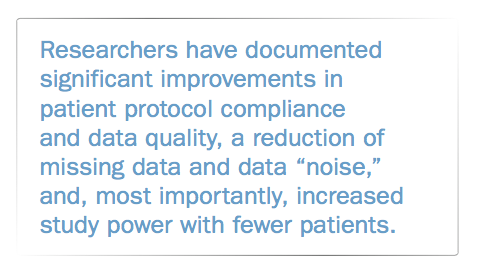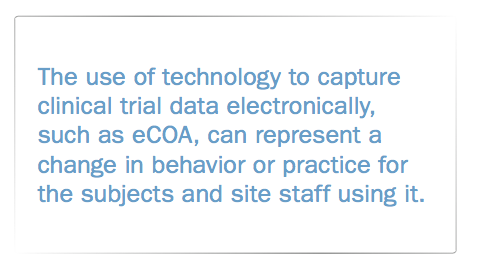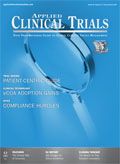Improving Patient Engagement through eCOA
Applied Clinical Trials
How the adoption of electronic clinical outcome assessment in trials can drive increased communication and patient reporting of events.

The use of electronic clinical outcome assessment (eCOA) represents a mechanism of capturing both patient and clinician reported outcomes digitally instead of on paper. The most common use of eCOA is for data capture in clinical trials. The evidence for obtaining improved data quality with digital systems over paper has grown substantially and as such, avenues for using eCOA in healthcare are being explored. eCOA captures data on handheld smartphones, tablets, browsers, interactive voice response systems, and patient’s own devices (bring-your-own-device, or BYOD), using secure systems that meet regulatory guidelines for electronic capture of clinical data. Consent for clinical trials details patient privacy, explains how the trial will be conducted, and confirms that the clinical site owns all clinical research data. The patient may authorize trial access to their lab, imaging, and electronic medical record (EMR) data for integration with their study data.
As adoption and the use of eCOA grows, additional learnings have provided a more complete understanding of how to use it effectively in order to derive the benefit of improved data quality. Herein, we will discuss the evidence of how the use of eCOA can promote increased communication between patients and clinical staff, increase patient reporting of events, and how tools such as training and patient engagement should be implemented to deliver maximal benefits from the use of technology. Collecting high quality data for clinical research requires a blend of clinical science and technology. Clinical science influences patient engagement behaviors with study design, collection schedules, predictive instruction, and assessment selection.
Patient-site communication
As more questions arise about improving patient engagement in clinical trials, many sponsors are finding that the answers may lie in the use of technology. Most pharmaceutical companies are considering methods for implementing novel technologies (e.g., activity trackers and mHealth devices) in their trials, in order to maintain better, more consistent interaction with study subjects. Many of these devices are still in proof-of-concept testing. Whether they will find their place in clinical research will be the decisions of global regulators. The US 21st Century Cures Act mandates that FDA regulate accessories based on their intended use, instead of based upon the parent device with which the accessories are associated.
What many sponsors may not realize is they already have access to regulatory-approved technology that can address current patient engagement challenges. Researchers will find that the use of eCOA not only improves data quality, but also offers the potential to improve patient engagement during clinical development.
The benefits of capturing high quality clinical trial data via eCOA have been widely recognized for more than a decade. Researchers have documented significant improvements in patient protocol compliance and data quality, a reduction of missing data and data “noise,” and, most importantly, increased study power with fewer patients.1
Here we review some of the well-established literature demonstrating how eCOA can also improve patient/clinician communication and candor vs. traditional paper-based COA, helping sponsors to keep patients better engaged during clinical development.
Patient/clinician interactions
eCOA prompts and increases patient/clinician interactions and enables subjects to think through their symptoms prior to meeting with site staff. As a result, patients are more likely to bring up clinical events in discussions with the clinical site, since the eCOA completion prompts their memory of additional details. For example:
- In a head-to-head comparison of electronic vs. paper completion using the EORTC-QLQ-C30, 48.9% of the symptoms reported electronically were addressed at the clinic visit vs. only 23.6% on paper.2
- In a study of 660 cancer patients, patients were given touch-screen tablets to complete electronic self-report assessments, which included items on symptoms and health-related quality-of-life. The results indicated that

- electronic patient-reported outcome (ePRO) reports to clinicians fostered discussions with patients at visits, clinicians were more likely to discuss issues flagged by the automated system at visits, and visit duration was unaffected.3
- Electronic COA ensures that every patient is asked the same questions in the same order at every visit without bias, halo, error, leniency, variation, interpretation, or mood. These electronic data are then available for site staff to intervene, augment, and guide care.
Reporting of more (and more severe) events
eCOA has been proven to increase patient candor. Patients are more likely to report more (and more severe) events electronically than on paper. This principle applies across a spectrum of indications and is generally applicable to patient-reported data. Patient reporting on diverse topics such as medication compliance and blood glucose levels are common examples.
- Diabetes subjects under-report hypoglycemic and hyperglycemic events on paper COAs 67% of the time.4 Further, diabetic patients using paper COA capture blood glucose values but fail to record them. A systematic review encompassing 11 diabetes studies showed that among these three categories of errors, nearly 50% of paper COA data was inaccurate.5 Electronic COA mitigates any such errors because the blood glucose readings being captured via fingerstick monitoring are wirelessly transmitted to the eCOA device.
- Several studies examined the impact of electronic and paper patient diaries on glycemic control and HbA1c levels. These studies found that increased monitoring in the electronic version may have encouraged positive behavioral changes and/or provided additional information on which patients could take action to improve their glycemic control. The use of a mobile electronic diary vs. conventional clinic visits were compared in patients from a diabetes clinic in a 12-week crossover design study.6 In the electronic diaries, subjects recorded meals and blood glucose levels, then received immediate feedback on their nutritional intake. There was a significant improvement in HbA1c for the time that subjects were using the electronic diary vs. the control period (HbA1c levels reduced 0.83%). Overall, the authors concluded that use of eCOA improved HbA1c levels.
- In another study comparing paper vs. electronic diaries, HbA1C levels decreased more in the electronic than the paper group. Furthermore, those who reviewed their electronic screens with their healthcare providers tended toward better glycemic control than those who did not.7
- The eCOA diary has proven to be an important and better tool than paper for patients and healthcare providers to improve clinical care. Good control of blood glucose levels is well recognized as a key element to attenuating disease progression for patients with diabetes. Studies show that for each percentage point decrease in HbA1c, microvascular complications are decreased by 35%.8â
Suicidal ideation and behavior
Self-reported electronic data capture (EDC) enables increased patient candor in suicidal ideation and behavior. Patients are more likely to reveal a higher frequency and severity of symptoms than ascertained by site interviewers. These phenomena are also well documented for topics including sex, drug/alcohol abuse, obesity, HIV, and mental health.
- In major depressive disorder and bipolar disorder, self-reported questionnaires were two to four times more likely to reveal higher frequency and severity of suicidal ideation than clinician-ascertained.9 In an eight-year study in children and adolescents, 98 families were followed (ages 5-18). Subjects completed a youth clinical interview and youth self-report assessments on suicidal ideation. Reports of suicidality were higher for the self-report group (25% and 30% in the younger and older cohorts, respectively) than the interview version (11% and 24% in the younger and older cohorts, respectively).10
- 68 patients admitted to a hospital or treatment facility for treatment of mood or anxiety disorders completed the Beck Depression Index (BDI) and clinician interview. Nine (18%) of the 50 participants who responded positive on the BDI were rated by clinicians as negative for suicide ideations following the face-to-face interviews.11
- Primary care physicians reported that an online electronic monitoring tool helped with engaging their patients because their patients were more willing to share how they were feeling in terms of symptoms, side effects and their suicidal ideation online. This enabled the clinicians to better address their health issues.12
Compliance and engagement
There is considerable evidence that using eCOA instead of paper is a mechanism for achieving improved compliance with patient reported outcomes collection.13 In addition to providing greater accountability in reporting, electronic media is noted by patients in general as more engaging compared to paper. For example, patient preference for using eCOA technology over paper has been shown across therapeutic areas and demographics; whether a population is technologically savvy or not, there is universal preference for using eCOA over paper. This is noted in published studies such as in oncology,14,15,16 diabetes,17,18 headache,19 inflammation/arthritis,20,21,22 pain,23 respiratory,24,25 and gastrointestinal disorders.26
Training needed for patients, caregivers, and clinical site staff
Programming a patient or clinician reported outcome assessment into a digital system reduces errors by avoiding errors in logic such as branching or scoring, but what technology alone cannot address is variability in patient and clinician understanding of how to complete the assessments. From a patient perspective, the total time spent on informed consent is the strongest predictor of patient comprehension in a clinical trial. Comprehension is maximized when consent takes at least 15 minutes.27 Studies show that training a patient on the instrument’s properties and clinical trial expectations is critical to reducing noise.28 And, regulatory guidances from the FDA and the European Medicines Agency (EMA) recommend training patients, caregivers, and site staff not only on the assessments but also on the EDC elements.29,30,31 Patients themselves strongly assert a need for training (see Figure 1 below). Over 95% of 437 patients who express an interest to participate in a clinical trial indicated that training is needed. In addition, caregiver variability32 and placebo effect33,34 are also noted to reduce data quality and can be similarly addressed with caregiver. Rater training for site staff conducting clinical interviews and assessments reduces inter- and intrarater variability and improves data quality.35,36,37

Didactic training, while useful, is not the most effective mechanism for sustained learning and improved rater reliability. Studies show that interactive training is an optimal mechanism for user engagement, improvement, and retention of learning.38,39,40 Interactive training-including video modules that reside on the same device as the eCOA assessment-represents a solution whereby training can always be accessible in an offline environment for the subject or site staff.
The use of technology to capture clinical trial data electronically, such as eCOA, can represent a change in behavior or practice for the subjects and site staff using it. This additional factor should be considered such that user interfaces are not only simple, but also engaging and motivate the desired behavior (compliance with patient and clinician reported outcome assessments). Clinical science and the use of patient engagement tools and strategies can provide evidentiary-based mechanisms for maximizing both data quality and quantity. Key factors to drive engagement and

compliance include a simplified study design and schedule, collection of key assessments only, minimized burden on subjects and sites, and the combination of useful trial information into a single location, such as the eCOA trial device. Tools such as alarms and reminders, graphics both static and interactive, progress bars during questionnaire completion, adaptive designs, on-device time estimates to patients of how long an assessment completion will take, appointment scheduling, educational information, training, and feedback on data/results during the trial all represent mechanisms by which user motivation and compliance with eCOA can be enhanced.
Conclusion
There is a wealth of evidence demonstrating the value of eCOA in fostering better communication and increasing candor between patients and clinical site staff, as well as in improving clinical outcomes. However, in use of technology, there are human elements that need to be considered regardless of the simplicity of the user interface. These aspects include the vital role for training and engagement strategies in parallel with the use of eCOA. There are aspects of obtaining high quality clinical trial data that are dependent on patients and site staff having a unified understanding of expectations and the following of a standard methodology for data capture.
This environment is markedly different from that of clinical care in many ways. For example, in clinical care if site staff are nurturing, encouraging and positive and there is a placebo effect, the impact of this behavior is very different than if this same behavior is replicated within a clinical trial where neutral behavior and accurate reporting are paramount to distinguishing placebo from treatment. Similarly, setting these expectations with subjects is also critical. Patients may feel obliged to report feeling better, when they are not, if it is not understood by the subject how important accurate reporting is to clinical trial outcomes.
Overall, combining science and technology can enable better patient-physician communication during a trial; sponsors will have the benefits of higher quality data collection, and tools/strategies such as training and patient engagement are key elements to achieving successful reporting of patient and clinical outcomes.
Susan M. Dallabrida, PhD, is Vice President, eCOA Clinical Science & Consulting, ERT; email: Susan.Dallabrida@ERT.com
References
1. Byrom B, Tiplady B. 2010. ePRO: electronic solutions for patient-reported data. Surray: Gower
2. Taenzer, P et al. 2000. Impact of Computerized Quality of Life Screening on Physician Behaviour and Patient Satisfaction in Lung Cancer Outpatients. Psycho Oncology, 9:203-213
3. Berry, DL et al. 2011. Enhancing Patient-Provider Communication with the Electronic Self-Report Assessment for Cancer: A Randomized Trial. Journal of Clinical Oncology. 29:1029-1035.
4. Mazze, RI et al. 1984. Reliability of Blood Glucose Monitoring by Patients with Diabetes Mellitus. The American Journal of Medicine. 77: 211-217.
5. Given, JE et al. 2013.Comparing patient-generated blood glucose diary records with meter memory in diabetes: a systematic review. Diabetic Medicine. 30:901-13
6. Tsang LC et al. 2001. Improvement in Diabetes Control with a Monitoring System Based on a Hand-held, Touch-screen Electronic Diary. Journal of Telemedicine and Telecare. 7:47-50
7. Ralston, JD et al. 2009. Web-based Collaborative Care for Type 2 Diabetes. Diabetes Care. 32(2):234-39
8. The Diabetes Control and Complications Trial Research Group. 1993. The Effect of Intensive Treatment of Diabetes on the Development and Progression of Long-Term Complications in Insulin-Dependent Diabetes Mellitus. NEJM 329:977-986
9. Gao, K et al. 2015. Disagreement between self-reported and clinician-ascertained suicidal ideation and its correlation with depression and anxiety severity in patients with major depressive disorder or bipolar disorder. Journal Psychiatry Research. 60:117-24
10. Klimes-Dougan, B.1998. Screening for suicidal ideation in children and adolescents: Methodological considerations. Journal of Adolescence. 21: 435-444.
11. Yigletu, H; Tucker, S; Harris, M; Hatlevig, J. 2004. Suicidal Ideation: Comparing Self-Report Versus Clinician Report. American Psychiatric Nurses Association. 10:1. 9-15.
12. Hetrick, S et al, 2014. Ensuring guideline-concordant monitoring of suicidal thinking and behavior after initiation of antidepressant treatment in 12- to 25-year-olds with depression. beyondblue.org.au
13. Stone A, et al. 2002. Patient non-compliance with paper diaries. BMJ 2002;324:1193
14. Hollen P, et al. 2012. A theory-based decision aid for patients with cancer: results of feasibility and acceptability testing of DecisionKEYS for cancer. Support Care Cancer. 2013 Mar; 21(3): 889–899.
15. Abernethy AP, et al. 2009. Feasibility and acceptability to patients of a longitudinal system for evaluating cancer-related symptoms and quality of life: pilot study of an e/Tablet data-collection system in academic oncology. J Pain Symptom Manage, 37(6):1027-38.
16. Ring A, et al. 2008. A Randomized Study of Electronic Diary versus Paper and Pencil Collection of Patient-Reported Outcomes in Patients with Non-Small Cell Lung Cancer. Patient; 1:105-113.
17. Tsang LC, et al. 2001. Patient preferences for using technology to track and self-manage diabetes. Journal of Telemedecine and Telecare; 7:47-50
18. Khurana L, et al. 2015. Measurement equivalence and patient preference for the SF-36V2 on a handheld device and smartphone app. Poster
19. Allena M, et al. 2012. An electronic diary on a palm device for headache monitoring: a preliminary experience J Headache Pain; 13:537-541.
20. Salaffi F, et al. 2009. The use of computer touch-screen technology for the collection of patient-reported outcome data in rheumatoid arthritis: comparison with standardized paper questionnaires. Clin Exp Rheum 27:459-468.
21. Greenwood MC, et al. 2006. Touch-screen computer systems in the rheumatology clinic offer a reliable and user-friendly means of collecting quality-of-life and outcome data from patients with rheumatoid arthritis. Rheumatol 45:66-71.
22. Richter JG, et al. 2008.Self-assessments of patients via Tablet PC in routine patient care: comparison with standardized paper questionnaires. Ann Rheum Dis 2008;67:1739–1741.
23. Stinson JN, et al. 2008. Working out the kinks: Testing the feasibility of an electronic pain diary for adolescents with arthritis. Pain Res Manage 2008; 13(5):375-382.
24. Cruz-Correia R, et al. 2007. Web-based or paper-based self-management tools for asthma patients’ opinions and quality of data in a randomized crossover study. Stud Health Technol Inform, 127:178.
25. Araujo L, et al. 2012. Clinical efficacy of web-based versus standard asthma self-management. J Investig Allergol Clin Immunol, 22:28.
26. Bushnell D, et al. 2006. Validation of Electronic Data Capture of the Irritable Bowel Syndrome-Quality of Life Measure, the Work Productivity and Activity Impairment Questionnaire for Irritable Bowel Syndrome and the EuroQol. Value Health 2006;9:98-105.
27. Fink et al., J Am Coll Surg. 2010. Predictors of comprehension during surgical informed consent. Jun;210(6):919-26
28. Tait, AR et al. 2015. Using digital multimedia to improve parents' and children’s understanding of clinical trials. Arch Dis Child, 100(6), 589-593.
29. FDA PRO Guidance. 2009. Guidance for Industry Patient-Reported Outcome Measures: Use in Medical Product Development to Support Labeling Claims.
30. EMA reflection paper on expectations for electronic source data and data transcribed to electronic data collection tools in clinical trials. 2010
31. CFR - Code of Federal Regulations Title 21. 2010
32. Kobak, KA. 2010. Inaccuracy in Clinical Trials: Effects and Methods to Control Inaccuracy. Current Alzheimer Research.7, 637-641.
33. Fernandes, R., Ferreira, J. J., & Sampaio, C. (2008). The placebo response in studies of acute migraine. J Pediatr, 152(4), 527-533, 533 e521
34. Diener, H. C., Schorn, C. F., Bingel, U., & Dodick, D. W. (2008). The importance of placebo in headache research. Cephalalgia, 28(10), 1003-1011
35. Khan, A et al. 2013. Assessing the sources of unreliability (rater, subject, time-point) in a failed clinical trial using items of the Positive and Negative Syndrome Scale (PANSS). Journal of Clinical Psychopharmacology.33(1):109-17
36. Kobak KA; Feiger,AD; Lipsistz, JD. 2005 .Interview Quality and Signal Detection in Clinical Trials.” American Journal of Psychiatry, 162(3), p. 628
37. Modell, J. 2014. When Placebo Response Isn’t Placebo. Response: THE PERILS OF HUMAN RATERS. Rho, Inc. http://www.rhoworld.com/rho/news/dr-jack-modell-contributes-commentary-clinical-informatics-news-placebo-response-and-human
38. Rosen J et al. 2008. Web-based training and interrater reliability testing for scoring the Hamilton Depression Rating Scale. Psychiatry Res. 161(1): 126–130
39. Kobak K et al. 2006. Enriched rater training using Internet based technologies: A comparison to traditional rater training in a multi-site depression trial. Journal of Psychiatric Research 40:192–199
40. Tait, AR. 2012. Evaluation of a prototype interactive consent program for pediatric clinical trials: a pilot study. J Am Med Inform Assoc, 19(e1), e43-45

Unifying Industry to Better Understand GCP Guidance
May 7th 2025In this episode of the Applied Clinical Trials Podcast, David Nickerson, head of clinical quality management at EMD Serono; and Arlene Lee, director of product management, data quality & risk management solutions at Medidata, discuss the newest ICH E6(R3) GCP guidelines as well as how TransCelerate and ACRO have partnered to help stakeholders better acclimate to these guidelines.
Gilead Shares Final Data from Phase III MYR301 Trial of Bulevirtide in Chronic Hepatitis Delta Virus
May 7th 2025Long-term results from the study show 90% of patients with chronic HDV who achieved undetectable HDV RNA at 96 weeks of treatment remained undetectable for nearly 2 years post-treatment.